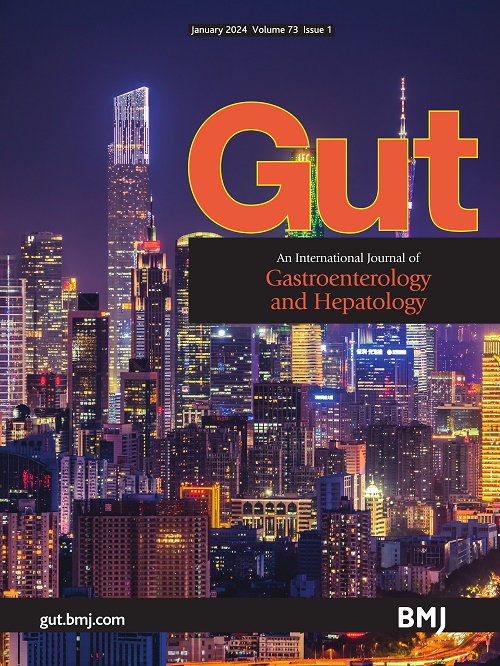T cells engineered to carry a high-affinity HBV-specific T cell receptor: a potent weapon against advanced HBV-related HCC
IF 25.8
1区 医学
Q1 GASTROENTEROLOGY & HEPATOLOGY
引用次数: 0
Abstract
Hepatocellular carcinoma (HCC) is the sixth most common cancer and the third most common cause of cancer-related death worldwide, and the incidence is predicted to further increase substantially within the next 20 years in all regions of the world.1 HCC surveillance in individuals at risk, including patients with liver cirrhosis as well as patients with HBV infection or metabolic dysfunction associated steatohepatitis, aims at early diagnosis of HCC, allowing for curative treatment such as resection or liver transplantation. In addition, locoregional therapies such as radiofrequency ablation, microwave ablation, transarterial chemoembolisation or radiotherapy are valuable treatment options in intermediate cancer stages. A large proportion of patients, however, are diagnosed in an advanced cancer stage, with multiple liver lesions or even extrahepatic metastases. These patients require systemic therapy. During the last few years, checkpoint-inhibitor based immunotherapy has become the first-line therapy for advanced HCC.2 While immunotherapy has prolonged survival in approximately one-third of patients substantially, a large proportion of patients has little benefit from immunotherapy. Unfortunately, adequate predictors of treatment response are still lacking. Possible reasons for inadequate response to immunotherapy may include non-canonical pathways of exhaustion of tumour-specific T cells that cannot be reverted by checkpoint inhibitors, as well as insufficient priming of tumour-specific T cells due to the immunotolerant liver environment or additional immune-evasive strategies of the tumour.3–5 These limitations of checkpoint-inhibitor-based immunotherapy may be circumvented by T cell engineering, redirecting autologous bulk T cells either to express a tumour-specific T cell receptor (TCR) or a chimeric antigen receptor (CAR). Engineered TCR T cells have the limitation that they depend on presentation of (tumour) antigens on specific human leucocyte antigens (HLA). For example, TCR …携带高亲和力hbv特异性T细胞受体的T细胞:一种对抗晚期hbv相关HCC的有效武器
肝细胞癌(HCC)是全球第六大常见癌症,也是导致癌症相关死亡的第三大常见原因,预计在未来20年内,世界所有地区的发病率将进一步大幅增加对高危人群(包括肝硬化患者以及HBV感染或代谢功能障碍相关的脂肪性肝炎患者)进行HCC监测,旨在早期诊断HCC,以便进行根治性治疗,如切除或肝移植。此外,局部治疗如射频消融术、微波消融术、经动脉化疗栓塞或放射治疗是癌症中期有价值的治疗选择。然而,很大一部分患者被诊断为癌症晚期,有多发肝脏病变甚至肝外转移。这些病人需要全身治疗。在过去的几年中,基于检查点抑制剂的免疫治疗已成为晚期hcc的一线治疗方法。2虽然免疫治疗延长了大约三分之一患者的生存期,但很大一部分患者几乎没有从免疫治疗中获益。不幸的是,仍然缺乏足够的治疗反应预测指标。免疫治疗反应不足的可能原因可能包括肿瘤特异性T细胞衰竭的非规范途径,这些途径不能通过检查点抑制剂恢复,以及由于免疫耐受的肝脏环境或肿瘤的其他免疫逃避策略导致肿瘤特异性T细胞启动不足。3-5基于检查点抑制剂的免疫疗法的这些局限性可以通过T细胞工程绕过,重定向自体大块T细胞来表达肿瘤特异性T细胞受体(TCR)或嵌合抗原受体(CAR)。工程TCR T细胞的局限性在于它们依赖于(肿瘤)抗原在特定的人类白细胞抗原(HLA)上的呈递。例如,TCR…
本文章由计算机程序翻译,如有差异,请以英文原文为准。
求助全文
约1分钟内获得全文
求助全文
来源期刊

Gut
医学-胃肠肝病学
CiteScore
45.70
自引率
2.40%
发文量
284
审稿时长
1.5 months
期刊介绍:
Gut is a renowned international journal specializing in gastroenterology and hepatology, known for its high-quality clinical research covering the alimentary tract, liver, biliary tree, and pancreas. It offers authoritative and current coverage across all aspects of gastroenterology and hepatology, featuring articles on emerging disease mechanisms and innovative diagnostic and therapeutic approaches authored by leading experts.
As the flagship journal of BMJ's gastroenterology portfolio, Gut is accompanied by two companion journals: Frontline Gastroenterology, focusing on education and practice-oriented papers, and BMJ Open Gastroenterology for open access original research.
 求助内容:
求助内容: 应助结果提醒方式:
应助结果提醒方式:


